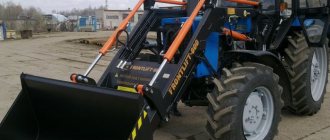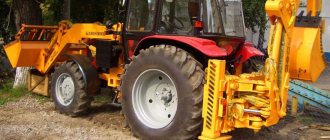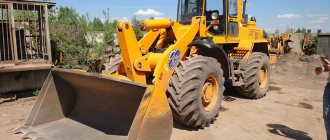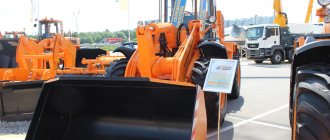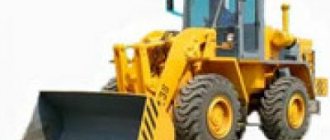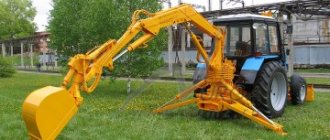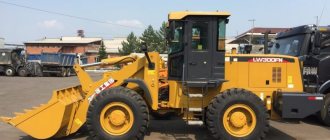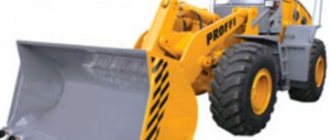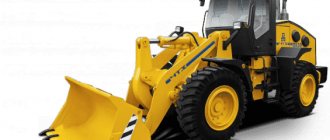FEATURES OF THE DEVICE AND PURPOSE OF KUN 10
The MTZ KUN 10 front loader (the most popular model) is produced at Salskselmash, one of the first Russian factories specializing in the production of special equipment. This enterprise was founded on the basis of the Gigant state farm in 1934 and is still successfully operating today. The agricultural direction in production became the main one in the 60s of the last century, and the first KUN 10 appeared in 1973. Since then, the model has been repeatedly improved - today it is a functional universal-type mounted boom.
Despite the fact that the KUN was originally intended for the MTZ tractor (in particular, for the MTZ 80 and MTZ 82), the design allows it to also be used to complete tractors of other models, for example, as a KUN for the T-40 tractor and some modifications of YuMZ and LTZ .
The MTZ 80 tractor with KUN, as well as its more modern modification MTZ 82 with KUN, have the following advantages:
The front-mounted KUHN for tractors has been successfully used for more than 50 years and has proven itself to be undemanding in maintenance and easy to operate. KUN for MTZ 82/80 tractors can be included in the machine package or purchased separately.
DESIGN
The KUN for a mini tractor is made in the format of a boom, which is controlled using 4 hydraulic mechanisms - 2 of them are involved in the process of lifting the load and 2 regulate the angle of inclination of the bucket. A chassis system is used as a drive, which also serves as a connector for aggregating the KUN to the main machine. The control panel for the loader's operating parameters is located in the driver's cab and is simple.
The manufacturer also offers a wide selection of additional replaceable equipment that can be equipped with the MTZ 82 tractor with kun:
CHARACTERISTICS
The universal KUN for a mini tractor, in particular the most popular modification KUN-10, has the following basic characteristics:
Attaching the bucket to the KUN at MTZ
The dimensions and performance indicators of the KUN are determined by the parameters of the chassis, which is used to attach the unit directly to the self-propelled unit.
MTZ 82.1 WITH KUN LOADER LOADING MANURE INTO A SPREADER (VIDEO)
Specifications
Most of the technical characteristics, including performance and dimensions, depend on the chassis used, but we can highlight the part that directly concerns the attachments along with replaceable parts.
| Characteristics | Indicators |
| Tractor compatibility | T-40, LTZ-60AB, YuMZ-6L/6M, MTZ-50/50L, MTZ-82/82L, MTZ-52/52L, MTZ-80/80L, as well as other Belarus tractor models, but it is recommended to clarify. |
| Passport carrying capacity: | |
| — rake grid, kgf | 500 |
| — other working parts, kgf | 800 |
| Loading height: | |
| - buckets, m | 2,5 |
| — rake grid, m | 3,5 |
| Available unloading angle for buckets, degrees | 60+5 |
Video review of the KUN-10 loader:
There are no similar entries.
HOMEMADE KUN FOR MTZ
The cost of the equipment, including compact models with lower productivity, is high, however, the KUN for the rear linkage of the MTZ or Uralets tractor can be made independently from available materials. Tractors of this brand are equipped with a hydraulic system that allows the KUN to be mounted on the MTZ rear suspension - this is convenient, and the installation of such a loader is simpler than its front-end counterpart. The advantage is the ability to select the optimal boom length and material unloading height
It should be noted that making a forklift yourself is justified if you have a sufficient amount of metal; sometimes buying a used product is more profitable.
In the process, you will need a welding machine, a tool for cutting metal, a hammer, a sledgehammer and a set of adjustable wrenches. Experience with a welding machine is desirable - the quality and reliability of welding, which affects the performance characteristics of the future loader, may depend on this.
Homemade KUN at MTZ
Drawings of KUN loaders for MTZ 80 and 82 of various capacities are presented on the Internet - we recommend that you carefully read them in order to cut metal with minimal waste.
The frame of the future loader consists of 2 rectangular frames. External and, accordingly, larger in size, it is aggregated to the rear canopy of the tractor. The internal one consists of sheet metal. A large hydraulic cylinder is fixed in its lower part, and a spacer is welded to the upper part, which acts as a stiffener.
The boom structure is prefabricated. The main part of the structure makes up 70% of the length of the product, is placed as close as possible to the frame and is aggregated with the cylinder. The middle part of the structure is attached to this fragment of the product using hinges, and the bucket is attached to it. An important parameter is the boom radius - if it is more than 2 m, the front semi-frame must be equipped with a counterweight.
The bucket can be purchased or made from sheet metal. the final design looks like a boomerang with three attachment points - central and one at each end.
The KUN installation on the tractor can be done independently. Before testing the device, be sure to check the reliability of the connections and fastenings.
You can buy a bucket, grips, forks and other equipment for a Kun MTZ mounted loader in our store using the link.
Source
Do-it-yourself Kun on the T-40 dimensions: drawings, photos
The T-40 tractor is a universal machine used with equal success in fields, construction sites and in public utilities.
The tractor belongs to the 0.9 traction class, which allows it to be used for a wide range of work from plowing and tillage to snow removal or transporting goods. Accordingly, the question arises about purchasing or manufacturing attachments for it.
A homemade “hitch” is often cheaper than a purchased one, and serves no less. Let's consider such common equipment as a homemade KUN on the T 40 - what it is, how it is used and how necessary it is.
Appointment of KUN
KUN is an abbreviation that stands for “universal mounted hay hauler”. Structurally, it is a basic “hitch” with a set of buckets of different sizes and (or) a forklift. This is multifunctional equipment capable of performing a wide range of work:
- transport bulk materials (sand, snow, manure, crushed stone, hay);
- load materials into trailers, mixing tanks, etc.;
- stack hay and straw into piles;
- remove snow;
- transport pallet cargo in warehouses;
- take out the garbage.
Kun is used to transport various goods
This is an ideal solution for a medium-sized farm, where you need to cultivate the field, clear roads, and load and unload building materials. One KUN will replace a whole set of specialized equipment. Perhaps special equipment is somewhat more convenient to use and more accurate to control, but if cheapness and simplicity are a priority, then KUN will be the optimal choice.
Depending on the type of work, you can produce a full set of replacement equipment, or you can limit yourself to just a bucket or boom.
Instructions for making KUN
Before work, you should carefully read the instructions on how to make a KUN on a mini tractor with your own hands, and watch the videos. Then you need to prepare the drawings. You can download them ready-made, or you can do them yourself, adjusting them strictly to the size and modification of the tractor.
The pattern of the parts is transferred to cardboard (corrugated cardboard from old boxes is suitable) in full size and cut out. Steel parts are marked and cut out using them. It is most convenient to mark with a marker - it does not erase, and after painting the marks will not be visible.
Necessary materials
For production you will need:
- For arrows: channel 10, sheet steel 4 mm.
- For racks: channel 18, sheet steel 10 mm.
- Fingers with blanks under them.
- Hydraulic cylinders grade 80-40-400 and 80-40-630.
- Loading lugs.
- Primer and paint for metal.
- Cardboard for cutting out templates.
- Tools you will need:
- Welding machine.
- Bulgarian.
- Metal scissors.
- Marker for marking.
The KUN for the rear linkage of the T 40 tractor is made of channel and steel. Factory structures are welded from the same material. The channel is used to manufacture the basic structure, onto which the actual working equipment is then hung: boom, loader forks, bucket.
A drawing is required for work
Working equipment can also be made independently from channel and sheet steel, but, of course, it is better to do without it - perhaps you can find a bucket from an old excavator in the garage or you can buy a used boom.
The fact is that without a sheet bending machine it is quite difficult to bend sheet steel exactly to size, and manufacturing using a vice and scissors will take so much time that the question of the payback of such a “homemade product” may arise.
Hydraulic cylinders and lugs can be removed from an old truck or purchased at a wrecking yard.
As a rule, any craftsman has a certain supply of channel bars, but even if you need to buy all the materials at the base, it will be almost half the price than buying ready-made equipment. You can also consider purchasing metal from your own hands. If it was stored correctly, it will not be inferior in quality to a new one, and will cost significantly less.
Procedure
Manufacturing steps:
- Weld the right and left half frames.
- Secure the working equipment to the front (right) half-frame.
- Weld the left half-frame to the left side member, and the right half-frame to the right.
- Connect the half-frames with crossbars. The result is a supporting frame.
- Install hydraulic cylinders on the frame and connect them to the tractor hydraulic system.
- Before installation, the structure must be primed and painted to protect it from corrosion.
- A properly manufactured KUN is capable of lifting up to 800 kg with a loader and up to 600 kg with a bucket or mounting hook.
It is very important not to try to increase the weight of the hitch in an attempt to achieve more power . You need to focus on the capabilities of the tractor, and the 0.9 class, although it has wide capabilities, still refers to light semi-professional machines. Constant overload will lead to wear and tear of the chassis, engine, and transmission.
Conclusion
The T 40 tractor with KUN is a multifunctional piece of equipment that will come in handy more than once on a farm or construction site. Self-manufacturing of equipment will reduce costs by almost half, and if some of the necessary materials are in stock, savings can be up to 70%. Such a “homemade product” will last for many years, after which it can be replaced with a purchased one or repaired with your own hands, again saving money.
, please select a piece of text and press Ctrl+Enter.
Source: https://traktoramira.ru/dopolnitelnoe-oborudovanie/kun-na-t-40-svoimi-rukami-razmery-chertezhi-foto.html
Pages
Questions can only be asked after registration. Please login or register.
I’m also interested in how to position myself using welding. I think this is the weakest link. I would like to come up with something with the ability to adjust, say, bolts.
Everywhere I saw the installation of axle boxes only by welding, and of course I did the same myself.
Yes, I understand. And if we say to make a ring within a ring, the inner ring (guide for the boring bar) is positioned relative to the outer one using bolts. The outer one is welded approximately in the center of the hole and then the inner one is adjusted more accurately with bolts.
The Internet is full of videos on how this is all done. First, they find an axis for the boring bar—somewhere with cones, somewhere with bushings—then they put supports with bearings on the installed and centered boring bar and weld them on the “legs.” Then they remove the installation (centering) mechanisms and off they go to work.https://www.youtube.com/watch?v=eACJ9jgyICA
Which regulations can I look at in more detail about this?
I lied, up to 1t. See ADR and rules for the transportation of dangerous goods.
Nitre with sulfur (6% is also a dangerous cargo?
The slob is wasting money in Kirov residents.
But alas, it’s impossible. Penalty for this. Only on the sly.
What motivates you? some kind of game.
IFA-M25, T-25A, T-40M, MTZ-80, 1PTS-2.5, L-201&L-651, etc.
Here is a method for boring such parts
Well, yes... by the time they arrive, set it up and spend it, the person will run out of money (if the piece of hardware is his personal)
so what... buy DIP400 or 500 and grind it.
advice must be given within reason.
I showed you the way. If the arms grow from the shoulders, then making such a device is not so difficult.
I was also quoted a sum of 25 thousand for a pair of coaxial holes. I made a boring bar and axle boxes in a similar way and bored more than ten pairs of holes. I spent about eight thousand on materials.
So you need to think a little, and not spit bile.
Can't you help with the device's drawings? You also need to insert the base of the boom on the miniex. Drawings can be sent to [email protected]
Which regulations can I look at in more detail about this?
I lied, up to 1t. See ADR and rules for the transportation of dangerous goods.
Sulfur itself is also a flammable substance, maybe a different amount, but still a dangerous cargo.
Here is a method for boring such parts
Well, yes... by the time they arrive, set it up and spend it, the person will run out of money (if the piece of hardware is his personal)
so what... buy DIP400 or 500 and grind it.
advice must be given within reason.
I showed you the way. If the arms grow from the shoulders, then making such a device is not so difficult.
I was also quoted a sum of 25 thousand for a pair of coaxial holes. I made a boring bar and axle boxes in a similar way and bored more than ten pairs of holes. I spent about eight thousand on materials.
So you need to think a little, and not spit bile.
Can't you help with the device's drawings? You also need to insert the base of the boom on the miniex. Drawings can be sent to [email protected]
Homemade mobile boring machine https://fermer.ru/forum/540/samodelnyy-mobilnyy-rastochnoy-stanok-339622
So I don't have any drawings. I’m telling you: everything was done in a hurry, simpler, cheaper. Whether you can try something or not. Then it was necessary to quickly repair the ex, and when the boring machine was repaired, it seemed like it was no longer a primary need and there was no longer enough time and finances for it. I made a boring bar and axle boxes. Feed carefully by hand. I forgot: I also made cones to center the boring bar.
Which regulations can I look at in more detail about this?
So it seems that you can transport it packaged.
Which regulations can I look at in more detail about this?
So it seems that you can transport it packaged.
There's nothing you can understand about these rules. The smaller the packaging, the more you can, but it turns out no more than a ton. About propane, diesel fuel and gasoline, I know exactly as much as possible because I got caught, about saltpeter it’s more difficult.
DT up to 1000l. (not a ton!) gasoline up to 333l. propane up to 15 pcs. 50 liter oxygen cylinders up to 24 pcs.
Yes, by the way, when I got there I was carrying 2000 liters. diesel fuel, but to prove to the traffic cops that there were 2000 liters. They couldn’t, although there were 10,200 liter barrels, I wrote out an invoice myself for 1000 liters, I said that the barrels were not full to make it easier to unload.
guys, good afternoon everyone! There’s one question that’s been nagging at me for a long time and I can’t find the answer to it. maybe someone knows. The situation is this: why on a loader (kun) do they make extra hinges at the junction of the cylinder and the bucket?! Why can’t it be done directly - the cylinder rod is attached directly to the bucket. why extra iron and lubrication points. It's the same story with excavators. By the way, I saw this on YouTube on Yumz. works fine. Why don't they do this at the factory? and what is the copier for, what significant benefits does it provide? If I understand correctly (copier) this is a rod running along the top of the boom.
“Better late than never,” said the Jew, laying his head on the rails and looking after the departing train.
guys, good afternoon everyone! There’s one question that’s been nagging at me for a long time and I can’t find the answer to it. maybe someone knows. The situation is this: why on a loader (kun) do they make extra hinges at the junction of the cylinder and the bucket?! Why can’t it be done directly - the cylinder rod is attached directly to the bucket. why extra iron and lubrication points. It's the same story with excavators. By the way, I saw this on YouTube on Yumz. works fine. Why don't they do this at the factory? and what is the copier for, what significant benefits does it provide? If I understand correctly (copier) this is a rod running along the top of the boom.
Why not, you can do it directly. Only when raising and lowering the boom do you need to adjust the position of the bucket, and with copiers and “extra hinges” the bucket rises and falls in parallel.
and what is the copier for, what significant benefits does it provide? If I understand correctly (copier) this is a rod running along the top of the boom.
The copier is called a copier because it allows the bucket to copy its position regardless of the height of the boom. That is, if in the lowered position of the boom the bucket is placed parallel to the ground, then in the maximum raised position of the boom the bucket will also remain parallel to the ground. Firstly, this is convenient when loading. Secondly, the copier system allows you to turn the bucket to a much larger angle with the boom raised as high as possible. Here we gradually approach the question of that.
Why on a loader (kun) do they make extra hinges at the junction of the cylinder and the bucket?! Why can’t it be done directly - the cylinder rod is attached directly to the bucket. why extra iron and lubrication points.
Just because the copiers provide the ability to turn the bucket to a larger angle in the upper position of the boom, a problem such as a break in the cylinder rod appears. Since the attachment of the cylinder to the bucket is “wrapped” behind the attachment of the bucket to the boom and the edge of the cylinder rod will bend. You can, of course, limit the inversion of the bucket to such an angle that the cylinder does not bend, but then the inversion angle is not sufficient for the substance that we are loading to fall out of the bucket well. And this is not convenient. Therefore, an additional system of hinges takes place so that the eversion angle of the bucket is maximum and does not bend the cylinder rod. This is clearly visible in the diagram.
The attachment point of the cylinder to the bucket went far beyond the axis of the boom. And if there was just a cylinder, without additional hinges, it would bend. Or the eversion angle would be significantly smaller. Therefore, I made a similar hinge for my old kun without copiers. To increase the angle of rotation of the bucket in the upper position of the boom.
_______________________________________ “Do what you can, with what you have, where you are.” Theodore Roosevelt ©
Source
Universal mounted bucket
A homemade KUHN for a mini tractor is one of the types of front loaders. It is indispensable when you need to transport or load large volumes of bulk (and other) materials, such as sand, crushed stone or grain.
The mini tractor itself differs in size from a full-fledged tractor. Using a bucket allows you to turn a simple tractor into a universal vehicle for a wide variety of types of work.
Front loaders have a number of advantages:
- easy maintenance;
- reliability;
- ease of installation and dismantling of equipment;
- serious load capacity for a small-sized tractor;
- ease of control due to enhanced hydraulics.
Making a ladle
You can buy a bucket for a mini tractor at any hardware store, but this is not the cheapest pleasure, so it’s easier to make it yourself. You don't need any special knowledge or materials here. To work, you need to stock up on drawings, a grinder, a welding machine and the material itself.
Advice! A metal sheet with a thickness of 6 mm or more and pipes of various diameters are best suited for these purposes.
- First you need to make the fasteners. It is welded to the box and engine, and a metal corner is welded underneath for reinforcement.
- The KUN itself is made from pieces of sheet metal. There is no point in bending the sheet to fit the shape of the ladle. It is much easier to cut rectangles of the required size and weld them together to form a ladle. The durability of the product depends on the quality of the seams. It is better to use pipes with a diameter of 100 mm for racks, and 50 mm for rods.
- The next stage is the installation of the hydraulic booster. For greater mobility, it is recommended to use a pipe with a diameter of 30 mm (it should not be more than 50 mm, otherwise the pipes will not move well inside each other).
- Now the support is welded to the front of the tractor and combined with the racks; gussets are used for reinforcement.
- A cylinder is used to control the rotation of the bucket. It is usually installed to the right of the bucket.
Safety precautions when working with a bucket
Making a bucket for a mini tractor is not very difficult, the main thing is to have knowledge and experience in working with welding, and be able to work with drawings. In order for the attachments to work correctly, you need to approach the work responsibly and do everything strictly according to plan, otherwise the result may not meet expectations, and the mini tractor itself with KUN will pose a danger to the operator.
Advice! If you have doubts about the success of the event, you should refrain from making the KUN yourself and purchase it in the store.
To ensure safety during operation, you should follow the operating rules:
- KUN can be used only for its intended purpose;
- When working, you should carefully monitor the bucket;
- When driving with a loaded bucket, you need to keep it lowered, that is, near the ground.
How to choose
When choosing equipment that is necessary for loading operations, it makes sense to compare the characteristics of construction machines of the same type: DT-75 and MTZ.
For DT-75
This machine can have several sets of attachments: for agricultural work, for general construction work, and drilling. A front-end loader on the DT-75 can be installed thanks to the installation of side-mounted semi-mounted equipment.
The updated modification of the DT, the engine for which is now produced in the city of Vladimir, has a new, more ergonomic cabin.
Loader specifications vary by model. PG 2 has a bucket with a capacity of 1.5 m³, the unloading height reaches 2.7 m with an angle of 50°. The width of the bucket edge (grip) is 2028 mm.
The PFP 1.2 front-end loader has a narrower specialization. It is designed for loading bulk materials and fertilizers. Its parameters:
- bucket capacity 0.9 m³;
- unloading height 2.5 m;
- working width 2035 mm.
In addition, combined and homemade loaders are used.
For MTZ
A loader based on the MTZ produced by the Minsk Tractor Plant is obtained by installing mounted units on the tractor. Its basis is a wide bucket with a grab for bulk materials. In the standard version (for example, the MTZ-1221 front loader) consists of:
- a controlled frame with a hydraulic system is the main part of the structure;
- chassis;
- nozzles
The MTZ-82, which has a kun as additional equipment, has also proven itself well. This is a swept unit controlled by four hydraulic drives. Two of them work in the horizontal plane, and two more regulate the movement of the bucket.
Difference in attachments
If the PKU - 0.8 is attached directly to the tractor frame, naturally disrupting the uniformity of the load during operation and putting pressure on the frame with the entire loaded mass, which leads to premature breakdowns when working with heavy loads, then the PF - 1 is equipped with its own frame, attached under the tractor to the rear axle , which evenly distributes the entire load.
In addition, PF-1 uses slightly more powerful cylinders, while the boom and other parts with mechanisms are made from reinforced (thickened) metal. Consequently, despite all the external similarities, the KUN on MTZ of different models still has significant differences in operation.
Note
Many skilled mechanics make the KUNS they need with their own hands, producing quite working and acceptable attachments. This does not mean that it is necessary and possible to refuse to purchase a high-quality factory product, but it does not exclude this possibility.
However, any homemade KUHN, even one manufactured according to all the rules and regulations, is certainly technically inferior to its factory-made counterparts.
